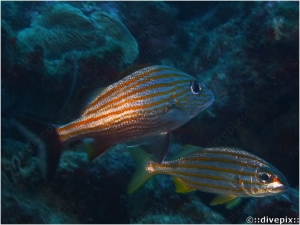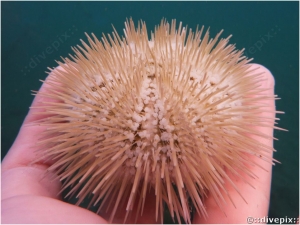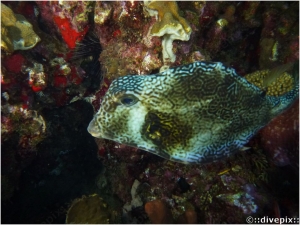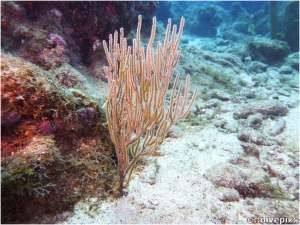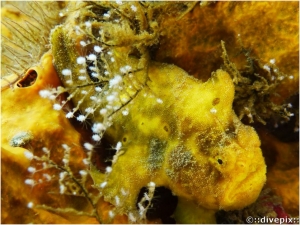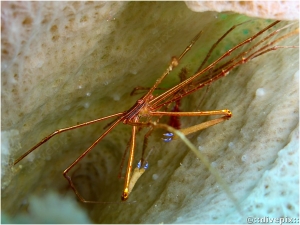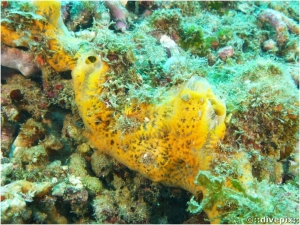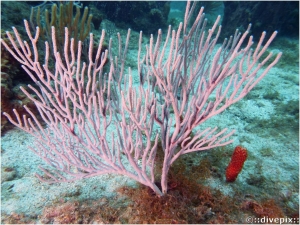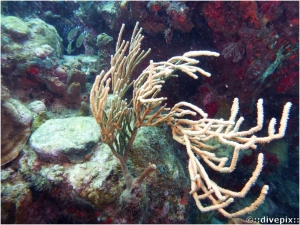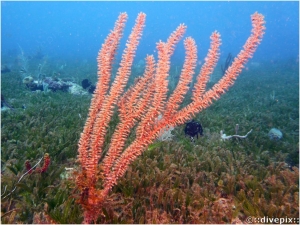




Eric H. Biass
mercredi, 26 mars 2014 21:51
Caesar Grunt
| Aspect: | Golden-Bronze lines over silver body, but features black fins (tail with lighter trailing edge) which differentites it from the smallmouth grunt (seen here in the background) with wich it could be confused at first sight. Another fish it could be mistaken for is the French Grunt (q.v.), but again this has yellow fins all round and mid-body side-lines are diagonal. |
| Population: | Common. |
| Notable feature: | Dark fins and bronze lines over silver. |
| Environment: | Usually found close to bottom in small schools and mixing with other grunts. |
| Behaviour: | Slightly shy but can be approached quietly. |
Publié dans
Lutjans (Gorettes)
Tags:
vendredi, 21 mars 2014 23:29
Variegated Sea Urchin
| Aspect: | Relatively short white to light brown spines over white body. |
| Population: | Common. |
| Notable feature: | White podia. |
| Environment: | Shallow waters of bays, on sea grass beds at depths of 10 metres maximum. |
| Behaviour: | - |
Publié dans
Echinodermes
Tags:
jeudi, 20 mars 2014 22:46
Buffalo Trunkfish
| Aspect: | Looks like a Cowfish (q.v.) at first sight, particularly those specimens boasting some of the latter's honeycomb pattern, but a close look reveals a) a larger size, b) no over-eye "horns", c) a very noticeable hump on the back, d) a longer tail fin root, and e) a dotted head and tail root (no lines there). |
| Population: | Less abundant than other box fishes. |
| Notable feature: | Prominent back hump. |
| Environment: | Around rock or coral boulders, relatively shallow waters (10 metres max). |
| Behaviour: | Difficult to approach closely. |
Publié dans
Coffres
Tags:
mercredi, 19 mars 2014 18:58
Yellow Sea Whip
| Aspect: | Generously branched gorgonian structure, colour varies from yellow to green depending on lighting conditions. In the area, simlarly configured Grooved-blade Sea Whips tend to be more pink/red-brown coloured. |
| Population: | Common. |
| Notable feature: | Branches are blade-shaped with white polyps growing from individual pockets located in the edges of the branch. Similar looking Grooved Blade Sea Whip (q.v.) sees polyps extending from a slit running along the branch edge. |
| Environment: | Close to reef edges in relatively shallow waters, typically at depths ranging from 5 to 20 metres. |
| - |
Publié dans
Octocoralliaires
Tags:
mercredi, 19 mars 2014 11:45
Longlure Frogfish
| Aspect: | Somewhat bulldog-faced with a stocky body and pectoral fins that act as front paws. Changes colour according to environment, here yellow sponges. |
| Population: | Common, but rarely seen because of its extremely effective camouflage |
| Notable feature: | Carries a lure (see red arrow on picture below) retained above the front lip by a very thin filament. Here the lure actually looks like one of the white polyps of the nearby Halocordyle disticha (q.v.) hydroid. |
| Environment: | Generally hides amongst sponges, in not too deep waters |
| Behaviour: | Can easily be approached closely, so convinced it is that it has not been spotted. |
Publié dans
Antennaires
Tags:
mardi, 18 mars 2014 22:42
Yellowline Arrow Crab
| Aspect: | Dark brown triangular body with golden longitudinal stripes, extremely long and thin light brown and golden legs, disproportionately long snout flanked by a pair of red eyes horizontally barred by three thin white lines. |
| Population: | Ubiquitous common. |
| Notable feature: | The two shorter front legs are each tipped with bright blue pincers |
| Environment: | Usually found inside vase sponges but also under rock or coral ovehangs |
| Behaviour: | Very easy to approach. |
Publié dans
Crabes
Tags:
mardi, 18 mars 2014 21:59
Orange Icing Sponge
| Aspect: | Yellow (rather than orange in this area), it is readily recognisable to its typically large and translucent excurrent openings. As seen in some of the pictures herewith, it often encrusts under the edges of existing coral plates, even dramatically heaving their surface when room is needed to emplace an excurrent opening. |
| Population: | Common. |
| Notable feature: | Large translucent excurrent openings. |
| Environment: | Usually found in presence of plate coral formations. |
Publié dans
Eponges
Tags:
dimanche, 16 mars 2014 16:11
Shelf-Knob Sea Rod
| Aspect: | Eunicea succinea often grows as a small and relatively dense bush, more or less in a single plane and more or less as a candelabrum, but not always successfully. |
| Population: | Common. |
| Notable feature: | Polyps are short and tend to grow upwards rather than perpendicular to the branch. |
| Environment: | Close to reef, shallow waters (down to 15 metres) |
| Behaviour: | - |
Publié dans
Octocoralliaires
Tags:
dimanche, 16 mars 2014 15:47
Warty Sea Rod
| Aspect: | Eunicea calyuculata is one of the rare sea rods not to grow in a single plane and can actually build a convoluted architecture. Dichotomous branching. Thus called because polyps grow from short wart-like mounds. |
| Population: | Common. |
| Notable feature: | Yellow-Beige when polyps are extended. Polyps tend to be short with stouter and blunter tentacles and pinnules (subtentacles) than other sea rods polyps. |
| Environment: | Rocky to sandy areas. |
| Behaviour: | - |
Publié dans
Octocoralliaires
Tags:
jeudi, 13 mars 2014 16:04
Swollen-Knob Candelabrum
Publié dans
Octocoralliaires
Tags:



